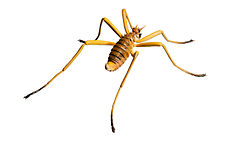Chionea
| Chionea | |
|---|---|
 |
|
| Chionea sp. Reconstrution - scale 20:1. (MUSE - Science Museum, Trento) | |
| Scientific classification | |
| Kingdom: | Animalia |
| Phylum: | Arthropoda |
| Class: | Insecta |
| Order: | Diptera |
| Suborder: | |
| Infraorder: | Tipulomorpha |
| Superfamily: | Tipuloidea |
| Family: | Limoniidae |
| Subfamily: | Chioneinae |
| Tribe: | Cladurini |
| Genus: |
Chionea Dalman, 1816 |
| Type species | |
|
Chionea araneoides Dalman, 1816 |
|
| Species | |
|
see text. |
|
| Diversity | |
| ca. 40 species | |
see text.
Chionea is a genus of wingless limoniid crane flies. It consists of two subgenera, the holarctic Chionea and palaearctic Sphaeconophilus. About 40 species are currently recognized in the northern hemisphere, but there are probably several undescribed species. They are commonly called snow flies.
Adults occur during winter, where they can be observed walking over snow. They produce glycerol in their hemolymph, preventing them from freezing.[1]
Up to 200 eggs have been found in female snow flies, which are laid singly (Schrock, 1992). The larvae occur under decaying leaves in wooded regions (Marchand, 1917). At least the larvae of some species seem to feed on feces in rodent burrows (Schrock, 1992).
Adults seem to actively seek out the coldest place they can find and drink water by pressing their proboscis against the snow (Marchand, 1917), but are not known to feed. Adult snow flies live for up to two months. They can walk at a speed of about 1,30 m per minute, and at least males have been observed to leap, without being provoked (Schrock, 1992).
Male C. alexandriana are about seven millimeters long.
They are easiest found on snowbanks in the afternoon, in areas that are to some extent forested. Some species have been found to be abundant on the floor of caves (Schrock, 1992).
The winglessness of the genus is probably attributable to the fact that at sub-freezing temperatures, it is very hard to generate enough energy for maintaining flight muscles. Also, the space normally taken by flight muscles is used to store eggs. However, the halteres have not been reduced and are innervated, thus probably serving as sensory organs (Schrock, 1992).
Mating is indiscriminate (probably because it is very hard to find a specimen of the other sex for them) and takes 30 to 70 minutes. While winged crane flies face in opposite directions, snow flies position themselves similar to many beetles.[2] This requires the male copulatory organs to be inverted 180 degrees (Schrock, 1992).
...
Wikipedia
